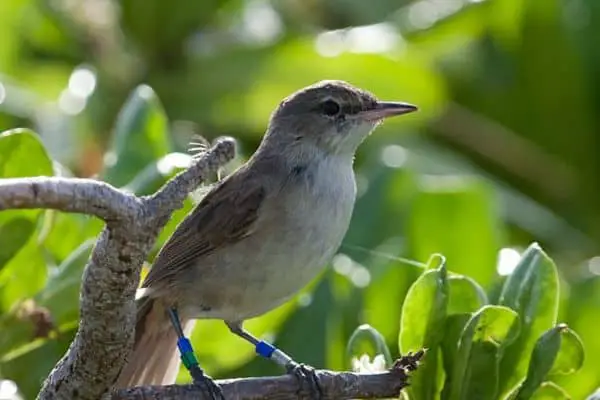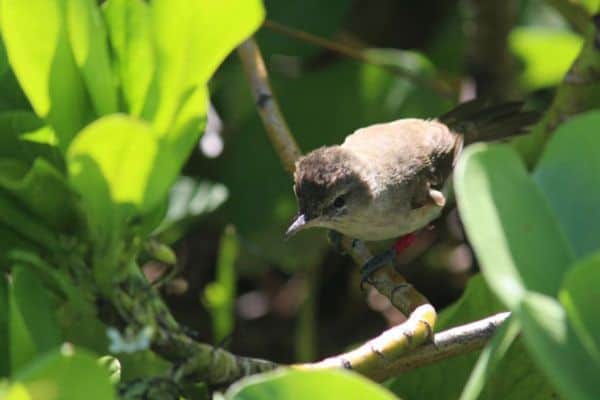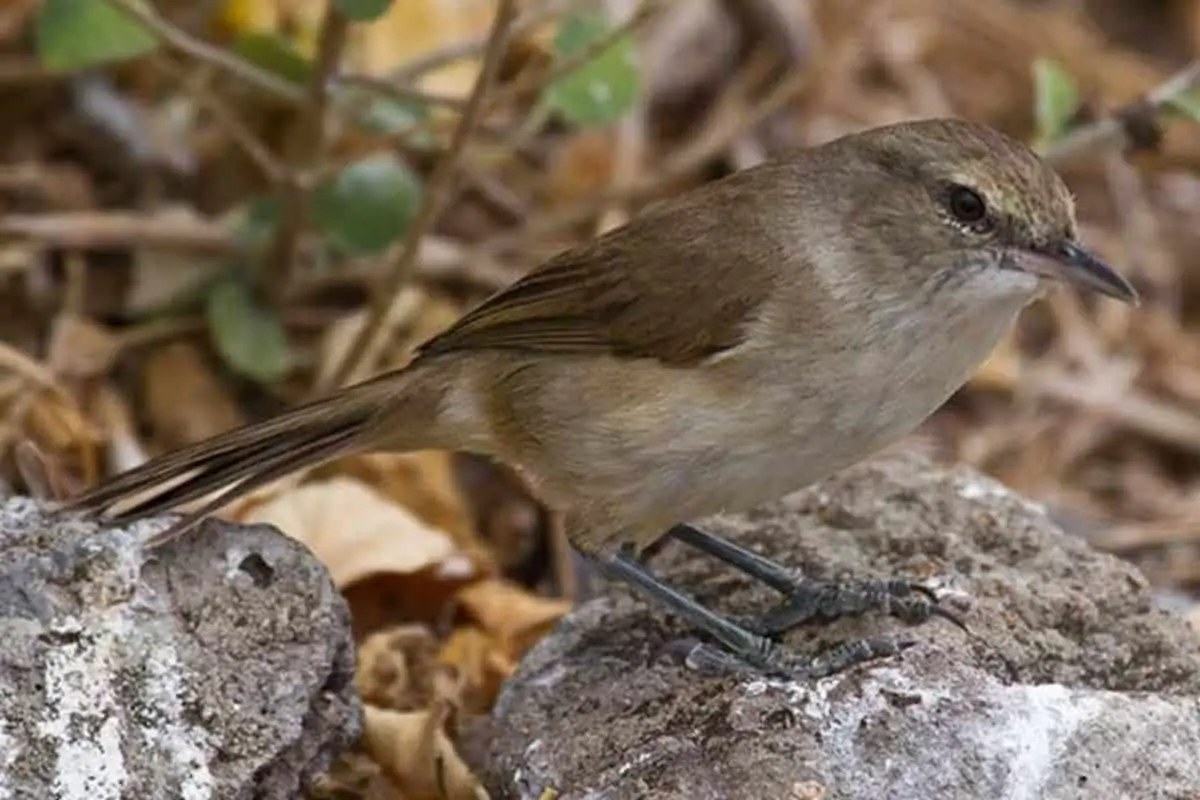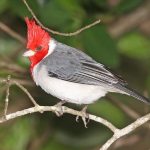Common Name: Millerbird
Scientific Name: (Acrocephalus familiaris)| Size | Diet | Range in Hawaii | Status in Hawaii |
|---|---|---|---|
| 5 in. - 6 in. | beetles, moths, flies, and spider | Laysan and Nihoa Islands | Critically Endangered |
The Millerbird (Acrocephalus familiaris) is a small and elusive bird species that is native to the Hawaiian Islands. With its unique appearance and intricate vocalizations, this bird is a fascinating sight and sound in its natural habitat. However, the Millerbird is also an endangered species, with only a few hundred individuals remaining in the wild.
In this article, we’ll explore the fascinating world of the Millerbird and learn more about its existence in Hawaii.
Millerbird
Appearance

The Millerbird is a small passerine bird with a distinctive appearance. It has a medium-sized body, measuring about 5 to 6 inches (12 to 15 centimeters) in length.
The bird has a slightly rounded head and a sturdy beak. The plumage of the Millerbird varies slightly between the two subspecies found on Laysan and Nihoa Islands.
The Laysan Millerbird (Acrocephalus familiaris familiaris) has a dark brown to blackish upper body with a grayish-brown head and nape. It has a pale eyebrow stripe and a lighter grayish-brown underbelly. The wings and tail are dark brown, and the legs are pinkish-gray. The male and female of this subspecies have similar appearances.
The Nihoa Millerbird (Acrocephalus familiaris kingi) has a more contrasting coloration. It has a dark brown or blackish upper body with a reddish-brown head and neck. The underbelly is pale gray, and it has a distinct white eyering. The wings and tail are dark brown, and the legs are pale pink.
Both subspecies have relatively inconspicuous plumage, which helps them blend into their preferred habitats of dense shrubs and vegetation.
Diet
The diet of the Millerbird primarily consists of insects and other invertebrates. It forages for food by gleaning insects from vegetation or by catching them in mid-air. The specific prey items include various types of insects such as beetles, moths, flies, and spiders.
Millerbirds are known to exploit a wide range of microhabitats within their island habitats, including marshes, shrublands, and grassy areas, to find their preferred food sources. They use their agile and slender bills to extract insects from vegetation or capture them while in flight.
Nesting
The nesting behavior of the Millerbird involves constructing a cup-shaped nest using various materials found in its habitat. The nests are typically built low to the ground, hidden within dense vegetation such as shrubs or grasses. Both male and female Millerbirds participate in nest building.
The nest is constructed using a combination of grasses, leaves, twigs, and other plant materials. The birds weave and intertwine these materials to form a sturdy structure. The inner lining of the nest is often made of softer materials like fine grasses or feathers to provide a comfortable environment for the eggs and hatchlings.
Millerbirds generally lay a clutch of two to three eggs, which are small and speckled in appearance. The eggs are incubated by both parents for a period of around two weeks. Once hatched, the parents continue to care for the young, providing them with food and protection. The nestlings grow rapidly and eventually fledge, leaving the nest and becoming independent.
Behavior

The Millerbird exhibits a range of behaviors that are well-suited to its island habitat in the Northwestern Hawaiian Islands. One prominent behavior is their vocalizations, with male birds producing complex and melodious songs. These songs serve multiple purposes, including territorial defense and attracting mates.
The Millerbird is an active forager, adept at searching for insects and other invertebrates within the dense vegetation of its environment. They employ a variety of foraging techniques, including gleaning insects from vegetation or catching them in mid-air.
Nest-building is another significant behavior, with both male and female birds participating in constructing cup-shaped nests concealed within shrubs or grasses. The Millerbird is also known for its parenting behavior, with both parents involved in incubating the eggs and caring for the young until they fledge.
Habitat
The Millerbird is primarily found in the Northwestern Hawaiian Islands, where it occupies specific habitats within this island chain. It is typically associated with areas of dense vegetation, such as shrublands, grassy patches, and marshes. These habitats provide the necessary cover and resources for the Millerbird’s survival.
Laysan and Nihoa islands are the main locations where the Millerbird is found in Hawaii. On Laysan, the bird inhabits grassy areas and shrublands, while on Nihoa, it occupies similar habitats but with a greater presence of shrubs and trees. Both islands offer a mosaic of vegetation types that provide suitable nesting sites and foraging opportunities.
Range
The Millerbird is a bird species found in the Northwestern Hawaiian Islands, which are part of the state of Hawaii. Specifically, it inhabits two islands in this region: Laysan and Nihoa. The Laysan population of Millerbirds became extinct in the early 1920s but was reintroduced to the island in 2011-2012.
On the other hand, the Nihoa population has been present since its discovery in 1923, although the estimated population size has varied over time.
Conservation Status

The Millerbird is listed as critically endangered, highlighting the urgency of its conservation status. This classification signifies that the species faces an extremely high risk of extinction in the wild. The main factors contributing to its critically endangered status include its limited range in the Northwestern Hawaiian Islands, habitat degradation, population fluctuations, and the potential for inbreeding.
Interesting Facts
1. Unique song
Male Millerbirds are known for their complex and melodious songs. These songs serve multiple purposes, including territory defense and attracting mates. Their vocalizations are a series of whistling and warbling notes.
2. Reintroduction efforts
The Millerbird population on Laysan Island became extinct in the early 1920s. However, successful reintroduction efforts were made in recent years, with translocations of birds from Nihoa Island to Laysan.
3. Limited distribution
The Millerbird’s distribution is highly restricted to just two islands in the Northwestern Hawaiian Islands. This limited range makes it particularly vulnerable to threats and highlights the importance of protecting its habitats.
4. Distinct subspecies
Two distinct subspecies of Millerbird have been identified: one on Laysan Island (A. f. familiaris) and another on Nihoa Island (A. f. kingi). These subspecies show some morphological and genetic differences.
Frequently Asked Questions
1. What are the main threats to the Millerbird?
The main threats to the Millerbird include habitat degradation, population fluctuations, potential inbreeding, and predation by invasive species.
2. How long do Millerbirds typically live?
The exact lifespan of Millerbirds is not well documented, but similar species within the Acrocephalus genus have been known to live up to 10 years in the wild.
3. How do invasive species impact the Millerbird?
Invasive species, such as rabbits and rats, have had detrimental effects on the Millerbird and its habitat. They cause habitat degradation and directly prey on the birds and their nests, contributing to population declines.
4. How does the Millerbird communicate?
The Millerbird communicates using a variety of vocalizations, including melodic songs, calls, and chirps. These vocalizations are used for territorial defense, courtship, and communication within their social groups.




